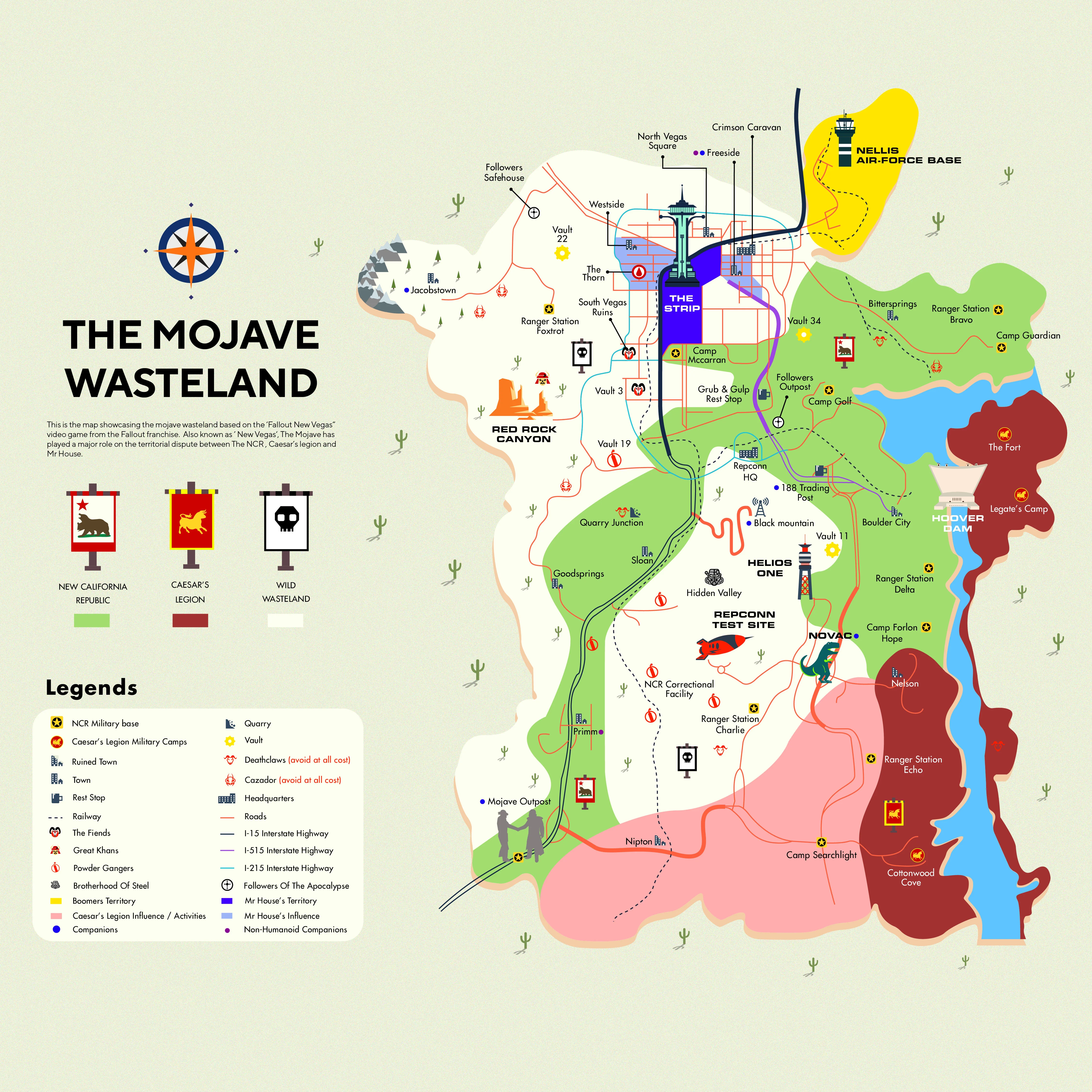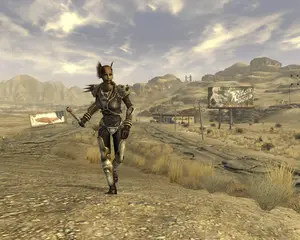I love Fallout: New Vegas. I keep going back to it, in a way that I don’t for Oblivion, or Skyrim, or Fallout 3. And yet, every time I sit down to play the game, whether reliving old memories or showing one of my favorite pieces of art to someone new, my enthusiasm quickly fades. For a long time, I had no idea why, but today I figured it out.
Minor spoilers ahead.
Nevada Route 164
See, Fallout: New Vegas, like all the Bethesda Fallout games, is set in a real place. The Mojave Outpost sits in Mountain Pass, CA, just southeast of Clark Mountain, where the Barstow Fwy becomes the Mojave Fwy. Primm, the Powder Ganger-afflicted resort town, is a conceptual fusion of the real world towns of Primm, NV and Jean, NV. I’ve driven the stretch of I-15 between Goodsprings and Mountain Pass, CA, several times over on the way to and from the DEF CON convention.
It’s a perfect place to set a video game. The huge elevation changes, the long stretch of empty desert from Mountain Pass up to Jean, and the encircling mountains make for impressive but constrained sight lines, as well as a multitude of foothills and vales to set side-quests and hidden locations in. Obsidian Entertainment, unsurprisingly, took full advantage of the landscape to set the first free-roaming section of the game.
 A map of the Fallout: New Vegas playspace, made by Reddit user waiii23.
A map of the Fallout: New Vegas playspace, made by Reddit user waiii23.
In most playthroughs, the player character will make their way from the sleepy town of Goodsprings, down the gangster- and scorpion-infested I-15, through the embattled town of Primm, and into the relative safety of the Mojave Outpost at Mountain Pass. There, the game begins to open up; several characters give the player quests, if they go looking for them; the collectable Star Bottle Caps appear for the first time; and there are even a few trading caravans and random encounters in the area in order to keep inquisitive players busy.
All of these signs, though, point toward a single path: Nevada Route 164 (in reality, Nipton Rd., which becomes Nevada Rt. 164 after passing through Nipton.) After Nipton, the player enters Nevada proper, and the game opens up completely. A normal playthrough could easily lead to Ranger Station Charlie, or Ranger Station Echo, or to fascist-occupied Cottonwood Cove. This stretch of road is the last place where Obsidian has a reasonable amount of narrative control over the player; there’s nowhere to go but east.
So what do they do with that control?
They throw two pointless, unavoidable combat encounters at you.
Killers with No Fixed Abode
Fallout: New Vegas is a lot like Dungeons and Dragons, and not just in the way most action RPGs are kinda, sorta like D&D. In fact, it’s an awful lot like the 3rd edition of D&D.
It’s got ability scores in the form of SPECIAL Attributes. These scores influence a large number of more specialized skills, which can each be individually increased. It’s got experience points which, once enough are accumulated, allow a player character to improve their skills and acquire unique abilities. It lets players choose which skills they change when they level up, unlike Skyrim’s skill training system. It’s got a universal currency, despite some trappings of state currencies, and unique, powerful items that can’t be purchased at any random vendor.
And, like Dungeons and Dragons, the most surefire way to get experience points, cash, and unique items is seeking out life-or-death fights and winning. In Dungeons and Dragons, taking this structure too seriously can lead to a problem commonly known as “murderhoboism” - player characters that wander the land looking for fights, just so they can get kills, gold, and magic items.
There’s nothing wrong with playing that way; it can be a lot of fun. But for players who value more character-focused games, which Fallout: New Vegas certainly strives to be, a good Dungeon Master will steer the players towards other methods of conflict resolution when possible. The best D&D games do include combat, of course, but in my experience they rarely involve unavoidable combat encounters that pop up out of the blue.1
 A Jackal Gang Member, on the stretch of I-15 heading from Goodsprings to the
Mojave Outpost in Mountain Pass, CA.
A Jackal Gang Member, on the stretch of I-15 heading from Goodsprings to the
Mojave Outpost in Mountain Pass, CA.
Player characters in D&D often find themselves on that stretch of Rt. 164: on the way from one major location to another, having just healed up, filled up on minor magic items, and maybe even picked up a hireling or two. It’s absolutely reasonable to throw a few encounters at them on the way. For instance, a DM might put some highwaymen on the road between two towns. The player characters might hear rumors about them in town, if they ask around; either way, the players would be wise to have their characters look out for signs of an ambush. With high stats and good luck, they might notice fresh tracks, foliage out of place, or even something moving in the trees. If they notice the ambush, the player characters might be able to sneak past, or stage a diversion, especially if they use some of their resources, like a wizard’s spells or an invisibility potion.
Even if they can’t make it past undetected, mortal peril isn’t necessarily on the cards. The highwaymen aren’t murderers by trade, after all; they’re robbers! They’ll ambush the player characters, surround them, and ask them - what else? - “Your money or your life!” If the PCs pay up, nobody gets hurt. If they don’t want to pay (and who would!), it’s a great opportunity for roleplay. A brash, headstrong barbarian might want to fight, but be tempered by the wiser cleric or ranger. A city-bred noble might be unused to encountering such danger, and might simply try to command the bandits to stand down. A happy-go-lucky halfling bard might try to sway them with a story and a song.
If all of that is past and combat does break out, the player characters killing or seriously injuring a single highwayman will likely lead to a second parlay, and a chance to negotiate an end to hostilities. No matter what, it gives the DM a chance to make the world feel more real, and the players a chance to flex their roleplaying muscles.
That’s not a option in Fallout: New Vegas.
Zero to Climax in No Tension Flat
A proficient player, or one who has spent a lot of time and skill points on stealth, might be able to sneak past the Jackal Gang Members lying in wait on that stretch of the highway - but that means completely avoiding the content. So does simply leaving the highway, and that’s likely to lead to combat anyway.
Any engagement with the Jackals that Obsidian chose to place, in the ruined buildings they modelled and textured and designed into that part of the map, is a combat encounter. Any combat encounter is a fight to the death. That frustrates me.
It frustrates me because it’s just about the least effective way to build tension. An NPC tells you the road is dangerous; you walk down the road and maybe see some enemies; you fight them and either die or kill them all. That’s it. It’s throwing away perhaps a dozen opportunities to “fail forward”; to let the game ratchet up the tension, give the players the opportunity to fail and end up in a worse situation, and the opportunity to make the right choice and move forward.2
It would be easy to fix, too. The game already has a method of valuing items based on individual NPCs and player characters’ stats; why not just have a “robbery” version, where you’re asked at gunpoint to hand over a certain caps value of items? The gang members tell you to fork over the caps; you can try to talk them out of it, and if you fail, the trading menu pops up. If you can’t or won’t meet the minimum, it’s combat. Then, the first time one of the gangsters loses a limb or dies, it’s back to dialogue to negotiate for a lower price to end the fight, or try to convince them that you’re dangerous enough to leave you alone.
I’m not saying a fight to the death shouldn’t be on the table, but it’s much less satisfying to go from zero to sixty the way Bethesda games so often do, and in a game as narrative and character focused as New Vegas, it absolutely stands out.
-
The exception to this is spontaneous, unavoidable combat encounters that make sense in the narrative and exist to push the players into new ways of thinking or give them additional resources. Matt Colville talks about this in the video “Orcs Attack” ↩︎
-
Matt Colville talks about this in his excellent video “Many Fail States” ↩︎